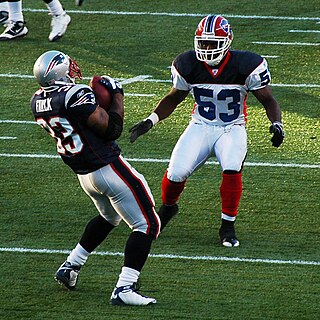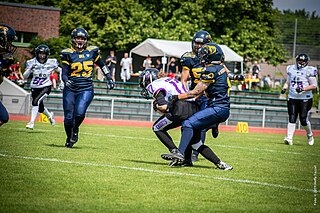Related Research Articles

Canadian football, or simply football, is a sport in Canada in which two teams of 12 players each compete on a field 110 yards (101 m) long and 65 yards (59 m) wide, attempting to advance a pointed oval-shaped ball into the opposing team's end zone.
A drop kick is a type of kick in various codes of football. It involves a player intentionally dropping the ball and then kicking it either 'as it rises from the first bounce' (rugby) or 'as, or immediately after, it touches the ground'.

A free kick is an action used in several codes of football to restart play with the kicking of a ball into the field of play.
The Laws of the Game are the codified rules of association football. The laws mention the number of players a team should have, the game length, the size of the field and ball, the type and nature of fouls that referees may penalise, the offside law, and many other laws that define the sport. During a match, it is the task of the referee to interpret and enforce the Laws of the Game.

A fair catch is a feature of American football and several other codes of football, in which a player attempting to catch a ball kicked by the opposing team – either on a kickoff or punt – is entitled to catch the ball without interference from any member of the kicking team. A player, usually a return specialist, wishing to make a fair catch signals his intent by extending one arm above his head and waving it while the kicked ball is in flight. A ball caught in this manner becomes dead once caught, i.e., the player catching the ball is not entitled to advance the ball, and the receiving team begins its drive at the spot where the ball was caught.

American and Canadian football are gridiron codes of football that are very similar; both have their origins partly in rugby football, but some key differences exist between the two codes.

The fair catch kick is a rule at the professional and high school levels of American football that allows a team that has just made a fair catch to attempt a free kick from the spot of the catch. The kick must be either a place kick or a drop kick, and if it passes over the crossbar and between the goalposts of the opposing team's goal, a field goal, worth three points, is awarded to the kicking team.
In rugby union, a player may mark a ball, which means that the player may catch it and cannot be tackled by rival players. The marking player can choose to take a free-kick or a scrum at the position of the mark.

A goal kick is a method of restarting the play in a game of association football. Its procedure is dictated by Law 16 of the Laws of the Game.

A comparison of American football and rugby union is possible because of the games' shared origins, despite their dissimilarities.
A comparison between American football and rugby league is possible because of their shared origins and similar game concepts. Rugby league is arguably the most similar sport to American football after Canadian football: both sports involve the concept of a limited number of downs/tackles and scoring touchdowns/tries takes clear precedence over goal-kicking.

A drop goal, field goal, or dropped goal is a method of scoring points in rugby union and rugby league and also, rarely, in American football and Canadian football. A drop goal is scored by drop kicking the ball over the crossbar and between the posts of the goal posts. After the kick, the ball must not touch the ground before it goes over and through, although it may touch the crossbar, the uprights or an opponent. A drop goal in rugby union is worth three points, and in rugby league a drop goal is usually worth one point.

Rugby union is a contact sport that consists of two teams of fifteen players. The objective is to obtain more points than the opposition through scoring tries or kicking goals over eighty minutes of playing time. The play is started with one team drop-kicking the ball from the halfway line towards the opposition. The rugby ball can be moved up the field by either carrying it or kicking it. However, when passing the ball it can only be thrown laterally or backward. The opposition can stop players moving up the field by tackling them. Only players carrying the ball can be tackled and once a tackle is completed the opposition can compete for the ball. Play continues until a try is scored, the ball crosses the side line or dead-ball line, or an infringement occurs. After a team scores points, the non-scoring team restarts the game at the halfway with a drop kick toward the opposition. The team with the most points at the end wins the game.

The place kick is a type of kicking play commonly used in American football, association football (soccer), Canadian football, rugby league, and rugby union. It was historically used in Australian rules football, but it was phased out of the game more than 100 years ago.
Rugby league football has accrued considerable jargon to describe aspects of the game. Many terms originate in the Laws of the Game. Some aspects of the game have more than one term referring to them. Different terms have become popularly used to describe an aspect of the game in different places, with notable differences between the Northern and Southern Hemispheres.
A comparison of Canadian football and rugby union is possible because of the games' shared origins, despite their dissimilarities.
In rugby league football, the Laws of the Game are the rules governing how the sport is played. The Laws are the responsibility of the Rugby League International Federation, and cover the play, officiating, equipment and procedures of the game.

The laws of Rugby Union are defined by World Rugby and dictate how the game should be played. They are enforced by a referee, generally with the help of two assistant referees.

A free kick is a method of restarting play in association football. It is awarded after an infringement of the laws by the opposing team.
References
- ↑ A detailed description of the punt-out/mark/kick procedure is given in the 1862 edition of the laws of Rugby School
- ↑ John Griffits. "Goals from marks, the numbering of players and Sunday internationals". www.espnscrum.com. Archived from the original on 24 October 2012.
- ↑ Rugby Union - ESPN Scrum - France v Romania at Beziers, Dec 11, 1971
- ↑ Laws of the game (1863)
- ↑ "McConville: Offensive mark & kickout make early impact". RTÉ Sport. 28 January 2019.